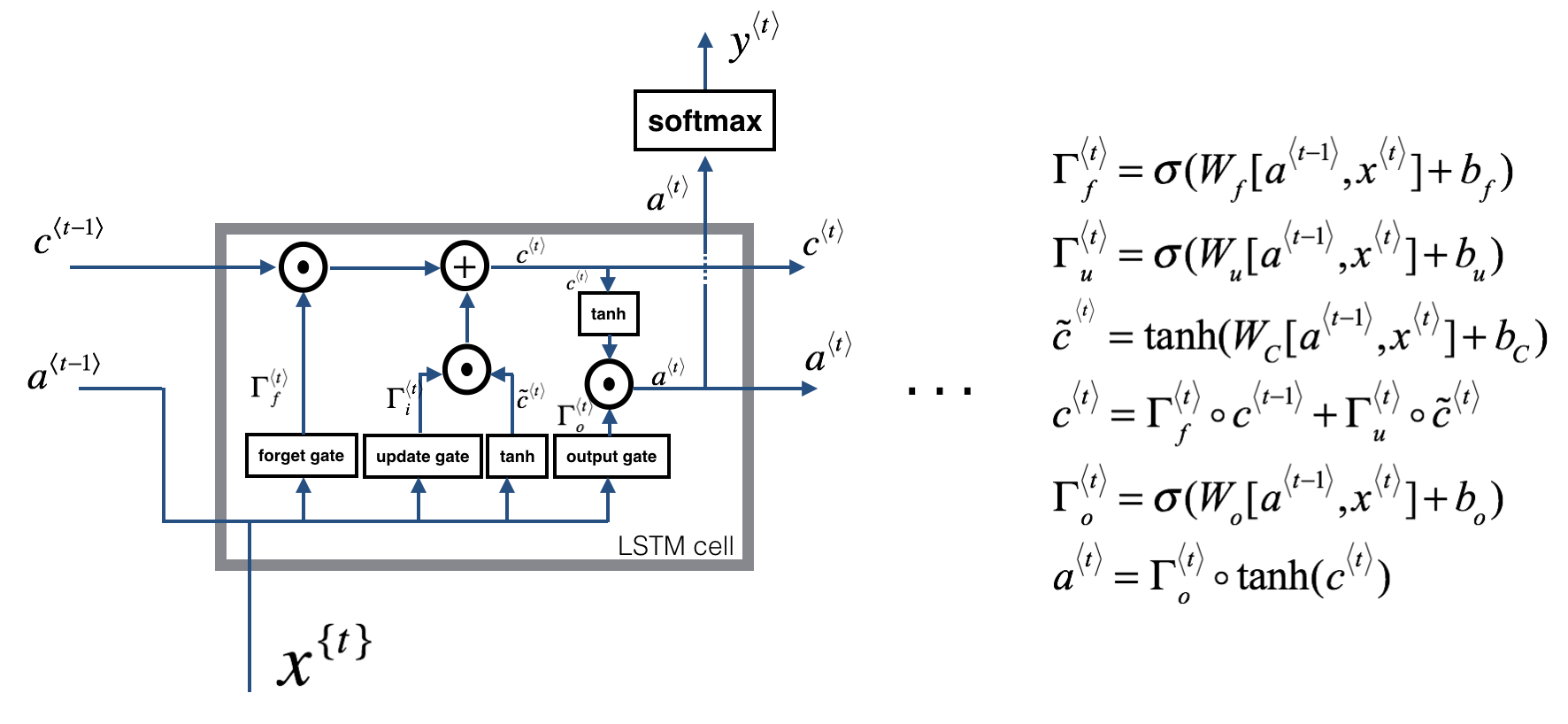Sequence Models
I: Recurrent Neural Networks
1.What are some examples of sequence data?
-
DNA/RNA/Protein Sequence
-
Stock change
-
Supply chain
-
Music generation
-
Speech recognition
-
Sentiment classification
-
Video activity recognition
-
Name entity recognition (one example here)
- Representing Words
- Words Index xT, yT
- Dictionary :
- Big company use 1 million words
- Commercial: 30k
- This lecture example: 10k
- One-Hot encoders
- Representing Words
2. Why don’t we use a standard network for sequence data analysis?
Problems:
- Input and outputs can be different lengths in different sentences
- You may pad or zero-pad each inputs up to that maximum length
- Don’t share features learned across different positions of text
- Huge matrix: each vector xT * max No. of words
3. How does a (uni-directional) recurrent neural network different from a standard network?
- To kick off, add a made-up activation at time 0
- Usually the vectors of zeros as the fake times zero activation)
- Or initialize a0 randomly
- Reads the 1st word in a sentence, predict whether the word is a part of the name y1 for X1
- Reads the 2nd word in a sentence, predict y2 for X2
- Passes the activation information from time step 1 to time step 2



4. What are the disadvantages of a RNN?
-
Exploding gradients:
- Parameters get large
- Gradient Clipping: when you derivatives explode or you see NaNs, then rescale numerical vectors. This is a very robust way.
-
Vanishing gradients:
- Harder to solve
- GRU
5. What are forward propagation and backward propagation?
- Forward Propagation
- Backward propagation through time
- The Unreasonable Effectiveness of Recurrent Neural Networks
6. Bidrectional Neural Networks (BRNNs)
Activation Functions:
Hidden Layers:
-
Relu
- If a lot of neurons die
- Leaky Relu
- MaxOut
- If a lot of neurons die
-
Don’t use:
- Sigmoid
- Gradient vanishing problems
- Loss of control because it’s not 0-centered (all +)
- Tanh (Hyperbolic Tangent Function)
- Gradient vanishing problems
- Sigmoid
Output layers
-
Softmax: For classification
-
Linear function: For regression
Note:
- For a real type speech recognition applications: complex modules.
- NLP processing applications: use standard BRNN when you can get the entire sentence all the same time
7.Deep BRNNs
- You don’t see a lot of deep-connected layers because of the large temporal dimensions
- 3 layers is already deep
8. Language modelling and sequence generation
-
A training set comprising a large corpus of text
-
Tokenization
- End of Sentence (EOS)
- Unkown words (UNK)
-
Vocabulary-level language model
-
Character-level language model
- Punctuations and space are also vectors
- Don’t need to worry about UNK, assign non-zero vectors
- Not good at capturing long-range word dependencies
- An example of character level language model Dinosaurus land notebook
-
Sequence generation
9. Gated Recurrent Unit (GRU)
-
What is GRU? GRU is a modification of the RNN hidden layer
-
Why GRU? GRU is much better capturing long range connections and helps a lot with the vanishing gradient problems.
What is a common GRU composed of?
-
Memory Cell Value (c): a new variable in GRU
-
Provide a bit of memory to remember
-
E.g. The dog, which already ate a sausage, was full.
-
The c will remember whether the subject of the sentence, “dog”, was singular or plural, so that when it gets much further into the sentence it can
-
For GRU, ct = at (output activation)
-
-
The optic gate
-
Notion: capital Greek alphabet gamma Γu
-
The job of the Gate, gamma u: to decide when do you update the value ct
-
[0 -1] For intuition, think of gamma as either 0 or 1
-
-
The relevance gate
- Notion: Γr
10. Long Short-Term Memory (LSTM) network
What is a LSTM unit and network?
Long short-term memory (LSTM) units are units of a RNN. An RNN composed of LSTM units is often called an LSTM network.
What is a common LSTM composed of?
- a cell
- an input gate
- an output gate
- a forget gate
How does LSTM work?
- Forget gate: LSTM should remove that piece of information (e.g. the singular subject) in the corresponding component. If one of the values is 1, then it will keep the information.
- Update gate: Once we forget that the subject being discussed is singular, we need to find a way to update it to reflect that the new subject is now plural.
- Updating the cell: To update the new subject we need to create a new vector of numbers that we can add to our previous cell state.
- Output gate: To decide which outputs we will use
